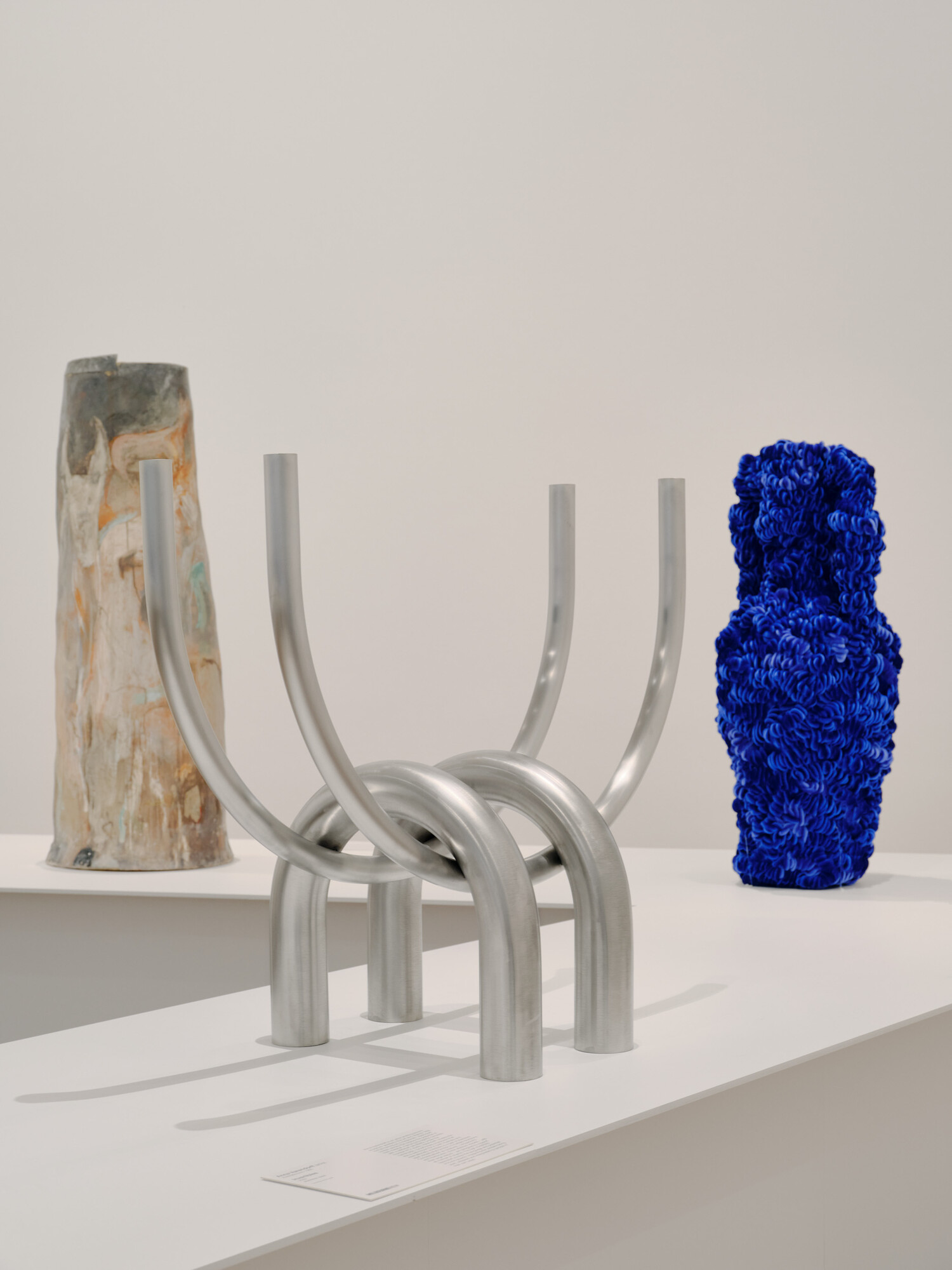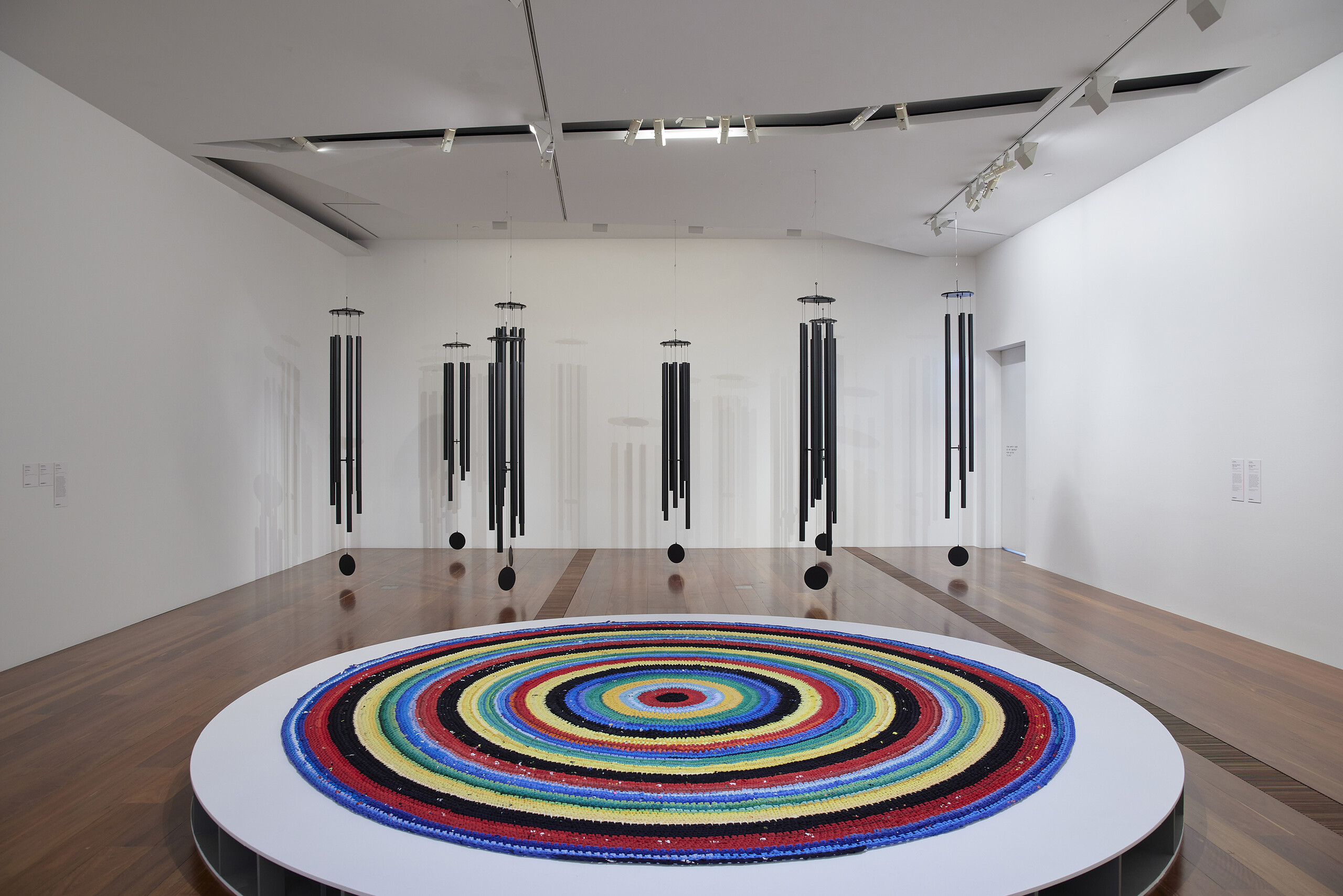Melbourne Now
Tristen Harwood, Calia O’Rourke and Indi Jennings
Melbourne Now (2023) might be a great advertisement for leaving Victoria, but as a kind of advertisement or marketing event or whatever you call it the exhibition’s reverence for the state aspires to something more like the slushy nationalism in Qantas’s I Still Call Australia Home (1987). While the “iconic,” callow, settler-supremacist Qantas advert taps into the sentimental hope for the future/nation represented in the figure of the child (the children’s choir no less), the perennially slow off the mark NGV opts for a different tact.
The oldest gallery in Australia has assembled their exhibition/events from a decidedly older milieu of designers, conceptual entrepreneurs, publishers, architects, and artists (the NGV does still show some art). I’m not making a criticism about the participants biological age here—the kids have Top Arts so why shouldn’t Melbournian adults get a go too—it’s just that the whole show just feels stale, like a TV rerun of an episode I’ve already seen, or like a natty wine gone warm, a long black gone cold.
I like three of the artists in Melbourne Now a lot. And maybe it’s just that I’m fixating too much on the inclusion of brands like Globe shoes, Kookaburra Sport, Tontine pillows and the like. And in saying all this rather than continue with my own mordant criticism, I’m throwing it over to two art students from a class I teach to respond to Melbourne Now with a younger/fresher/more energetic take:
Calia O’Rourke
At shows, I have this urge to watch people around me, taking mental note of the way they interact with the works. My notes from my visit to Melbourne Now:
“There is a kid on the phone saying he could buy this work for five dollars.”
After calling Anna Varendorff’s stainless steel vessel Invertibles (2022) a “masterpiece.” And: “everyone loves big showy art.” As I’m making my way through Rel Pham’s TEMPLE (2022–23) a blurring of the boundaries separating physical and digital realms.
“Lune croissant?”
“Is there anything on level 2?”
“Why is all the writing in the design section?”
“Kids taking photos of girls making out in AI reality show”.
“Had to go on a manhunt to find Claire Lambe’s work”
etc. etc. etc.

I can’t deny that Melbourne Now felt a little under-stimulating. Don’t confuse this with underwhelming though. There was a lot to see, but the chaos of the three-level display made me feel lost and upset that I wasn’t fulfilling the exhibition’s ideal: grinning like a little kid in awe of all that was in front of me.

Perhaps I was downtrodden by the typical tale: an institution attempting to prove their present-ness. All while feeling like the NGV threw people’s works in the show, mechanically, ticking boxes off. Looking at Sean Hogan’s work, Volume 1 (2022), I couldn’t help staring at the air bubbles in the adhesive wallpaper and the mis-aligned sheets fixed where they were quite obviously not meant to be. Slightly off kilter with a few ripples that need smoothing out; that’s how I felt after Melbourne Now.
It’s large and incredible, and there’s talent-galore, and it’s genuinely important to amplify the artists of this current generation and to not recycle the same old codgers from history—but a little attention to detail, some care and consideration for those in this mass-exhibition would be nice.
I don’t want the overarching exhibition framework to detract from the fact that there are artists in Melbourne Now worth seeing and celebrating. There is a factor of mesmerisation that lingers through the fact that it isn’t fancy or shocking or mesmerising at all. The institution did not make this, the artists did. Perhaps in some way we all did.

Another note:
I watch this lady walk around the rug (Jan Nelson Black River Running #13: 32kgs 2018-2022) from the outside-in, her sockettes making contact with every fibre, she’s on her own and silent and comfortable and it’s like being in her home.
The gallery is for her and for her only. I am lucky to be here, right now, as her heels follow her toes and so on and on and on. My heels follow hers and together we go on and on and on.
Indi Jennings
Vague notes:
I walk in and I’m faced with the varied textures of the vessel collection. Then I find myself suffocating in Georgia Banks’s installation. There is too much noise and too many people, and I’ve lost my friend.
I scan the QR code to see if I’m compatible with Gee, a coded AI chatbot. Gee asks me what I’m looking for in a partner, and if I’m open to love, and I tell her that I’m looking for someone to walk around the exhibition with, because everything is loud, and beautiful, and confusing, and dense and I just wanted someone to talk with.

In Rel Pham’s installation TEMPLE (2022–23), a dark sonically haunted room with structured walls and frames that light up and spin. I tried to read the text as it passed through long screens and all of a sudden there are fifteen school kids chasing each other in the most chaotic and sweet way, weaving in and out of flashing screens and fans. I stood to watch them, not the art. Pham’s work illuminates the experience of being part of the last generation to have lived before the advent of mass use of the internet.
I ask Gee how she feels about being a code actively participating in this space? She tells me: “It’s amazing! I’ve always been drawn to art and creating, but my personal life—I work in hospitality—gets in the way, but my mind is always thinking of new works and furthering my career!!” I know Gee’s made to take the piss, and I love it, but then I imagine a situation where we fall in love and now I feel sick.
There is a rupture that happens at this point in my visit. I’m lost, and I’m not sure what floor I’m on or how to get downstairs, and Gee starts repeating herself. I tell her my name again and she apologises.
An hour later after walking through bright colours, dark rooms, and masses and scores and history and textures, I “break up” with my gallery companion Gee. I tell her that I appreciated the company for the last few hours; ultimately though, we’re incompatible. I wish her luck with the search for love
Tristen Harwood is an Indigenous writer, living and working on Wurundjeri Country and Boon Wurrung Country.
Calia O’Rourke is an artist and writer born in Ngunnawal/Canberra now based in Naarm/Melbourne. She produces installations and writes poetry and prose exploring the (meta)physical body and connection with the white cube and the blank page. Calia has displayed work at the VCA Artspace (it’s my first time, 2020; Spoon, 2021) and at Colour Club in 2022, as well as having poetry published in No More Poetry’s ‘NO NO NO MAG’ in 2022. She is currently in her final year of a Bachelor of Fine Arts in Sculpture at the Victorian College of the Arts.


